Updates for ‘Otto Ege Manuscript 19’
August 12, 2020 in Manuscript Studies, Uncategorized
A Glimpse of
‘Otto Ege Manuscript 19’
While It Was Still Intact
Portable Quarto Bible in the Latin Vulgate Version
Italy, circa 1275, with Illuminations made apparently in Paris
Double columns in 48 lines
circa 235 × 170 mm <written area circa 153 × 107 mm>
[Posted on 12 August 2020]
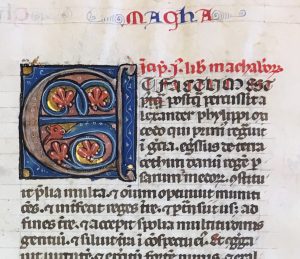
Opening of the Book of Maccabees in Otto Ege MS 19. Private Collection.
Continuing to explore the tracks of manuscripts dispersed by Otto F. Ege (1888–1951), we gain access to the Sotheby’s catalogue for the auction in 1936 from which the manuscript mostly known as ‘Ege Manuscript 19’ came to him. For the name, see Scott Gwara, Handlist, Number 19 (page 124).
For access to the elusive catalogue, we thank Stephen Massey, Bruce McKinney, and our Associate, Eric White, for help with the quest while libraries remain closed through months in 2020.
We began to study the manuscript when the owner of one of its leaves, J. S. Wagner, contacted us on account of our blog, which reported discoveries for some other Ege manuscripts. For example,
- Updates for Some ‘Otto Ege Manuscripts’ (Ege MSS 8, 14, 41, and 61)
- Some Leaves in Set 1 of ‘Ege’s FOL Portfolio’ (Ege MSS 8, 14, 19, and 41)
Our discoveries for Ege MS 19 are reported here:
- Some Leaves in Set 1 of ‘Ege’s FOL Portfolio’ (Ege MSS 8, 14, 19, and 41)
Now we examine the written record for the Provenance and the state of the volume before Ege.
Provenance
The first post on fragments of the manuscript could mention the known provenance of the volume thus, and we quote:
Ege’s Source for the Manuscript When Intact:
The (or A) Lacaita Vultage Bible
Ege acquired this folio Bible manuscript while it was still intact. It was sold at Sotheby’s, London, on 20 July 1936, as lot 20 [sic; recte 24]. It appears in the Catalogue of valuable printed books, illuminated and other manuscripts, autograph letters, Persian and Indian miniatures, etc. . . . which will be sold by auction . . . on Monday, 20th of July, 1936, and two following days (London: Sotheby & Co., 1936), lot 20.
(I have yet to see that auction catalogue. My research on this manuscript had reached the stage of seeking to examine this catalogue entry in early March 2020, when the institutional library holding it, the Grolier Club, had to close its doors for visits by researchers and for the work of staff onsite.)
Until that entry becomes accessible to view, it is possible to identify some relevant points. The book came from the collection of Sir Joseph Lacaita (1813–1895) — lawyer, politician, scholar, bibliographer, and authority on Dante — which his son Charles Carmichael Lacaita (1853–1933) had inherited, and from whose estate in turn came this Bible. Given Sir Joseph’s origins, travels, and sojourns in various countries, including Italy, and his wide range of connections, the time, place, and source for his acquisition of this Bible appear to remain open.
The manuscript does not appear in the 1937 Census report of a “selection” of manuscripts in Ege’s collection, then housed at 1888 South Compton Road, Cleveland, Ohio. The Census of Medieval and Renaissance Manuscripts in the United States and Canada, by Seymour de Ricci with the assistance of W. J. Wilson (New York, 3 vols., 1935–1940), Volume II (1937), pages 1937–1948, lists 71 manuscripts, and alludes to more. The Census does include a manuscript which Ege acquired in 1935, the year before the sale of Lacaita’s Bible: Handlist 82 (a 15th-century Antiphonal from Flanders) = Census number 68 (at page 1947).
And now, we report:
The Bible According to Sotheby’s in July 1936
The Cover for the Auction Catalogue for Sotheby & Co., of 34 & 35, New Bond Street, London W. (1), declares the offerings by genre and by collector.
CATALOGUE OF VALUABLE PRINTED BOOKS, ILLUMINATED AND OTHER MANUSCRIPTS, AUTOGRAPH LETTERS, PERSIAN AND INDIAN MINIATURES, ETC., COMPRISING The Property of the late CHARLES CARMICHAEL LACAITA, ESQ; The Property of MRS. ALYMER DIGBY; The Property of COL. J. M. FLEMING; [et al.]
The “Illustrated Catalogue”, with “15 plates”, had the price of “5/-“. Among the 3 “Days of Sale”, the “FIRST DAY” of “Monday, July 20th” covered “Lots 1 to 235”.
The entry of interest to us for ‘Ege Manuscript 19’ is Lot 20 (with no plate). It states in full:
BIBLE. LATIN. ILLUMINATED MANUSCRIPT ON VELLUM, BEAUTIFULLY WRITTEN IN A VERY NEAT GOTHIC SCRIPT, double columns, 48 lines to a page, 498 ll., NINETY-FIVE LARGE AND SMALL ILLUMINATED INITIALS, finely designed and coloured and heightened with gold, many with marginal continuations; the Interpretation of the Hebrew names on 32 ll. at end; a few small wormholes through a few leaves at beginning and end. ON THE WHOLE IN VERY GOOD AND CLEAN CONDITION WITH WIDE MARGINS, calf gilt, g. e.
4to (9 1/2in. by 6 3/4 in.; 235 mm. by 173 mm.)
PROBABLY ITALIAN, XIV Century
The entry gives something to go with.
Components
From these few details, we can know or surmise the former components, whose traces might be detected in dispersed pieces which have been identified in various places.
To whit:
- 1 volume, “quarto size”, measuring 9 1/2″ × 6 3/4″ (or 235 × 173 mm)
- Binding in “calf gilt”, with “g[ilt e[dges]”
[Date of binding unspecified] - Bible in Latin [in the Vulgate version, to judge by the surviving leaves, and with prologues]
- “498” folios [counting endleaves or endpapers?]
- Text layout in “double columns, 48 lines to a page”
- “Beautifully written in a very neat Gothic script”
- “95 Illuminated initials” (both “large and small”), “finely designed and coloured and heightened with gold, many with marginal continuations”
- Accompanied by “The Interpretation of the Hebrew Names on 32 l[leaves] at end” [likewise in double columns?]
- “On the whole in very good and clean condition with wide margins”
- But with “a few small wormholes through a few leaves at beginning and end” [presumably from adjacent wooden boards of the then-current binding or some earlier one]
- Date and Place of Origin: “Probably Italian, XIV Century”
Attribution by Style
The merits of the assessment of the manuscript as “probably Italian” and “XIV Century” deserve consideration. It is unknown whether the assessment derives from some form of identification on or in the book itself, or pertains mainly to the expertise or awareness of the cataloguer. Unless other information appeared within the volume, the style of script and illuminated initials would have governed the attribution — as it still does.
A sample page from within the Catholic Epistles in the New Testament, with illuminated initials for the openings of Books and smaller penwork initials for the openings of their Prologues:

UNCG University Libraries, University of North Carolina at Greensboro, Leaf from Ege MS 14, original verso. Image Public Domain.
Binding
Whereabouts unknown. Perhaps its parts still reside somewhere among the remnants of Ege’s collection, like the parts of Ege MS 51 and Ege MS 14 now at the Beinecke Rare Book & Manuscript Library at Yale University. See
- More Discoveries for ‘Otto Ege Manuscript 14’ (a large-format Bible)
- More Discoveries for ‘Otto Ege Manuscript 51’ (a medium-format textbook in several volumes)
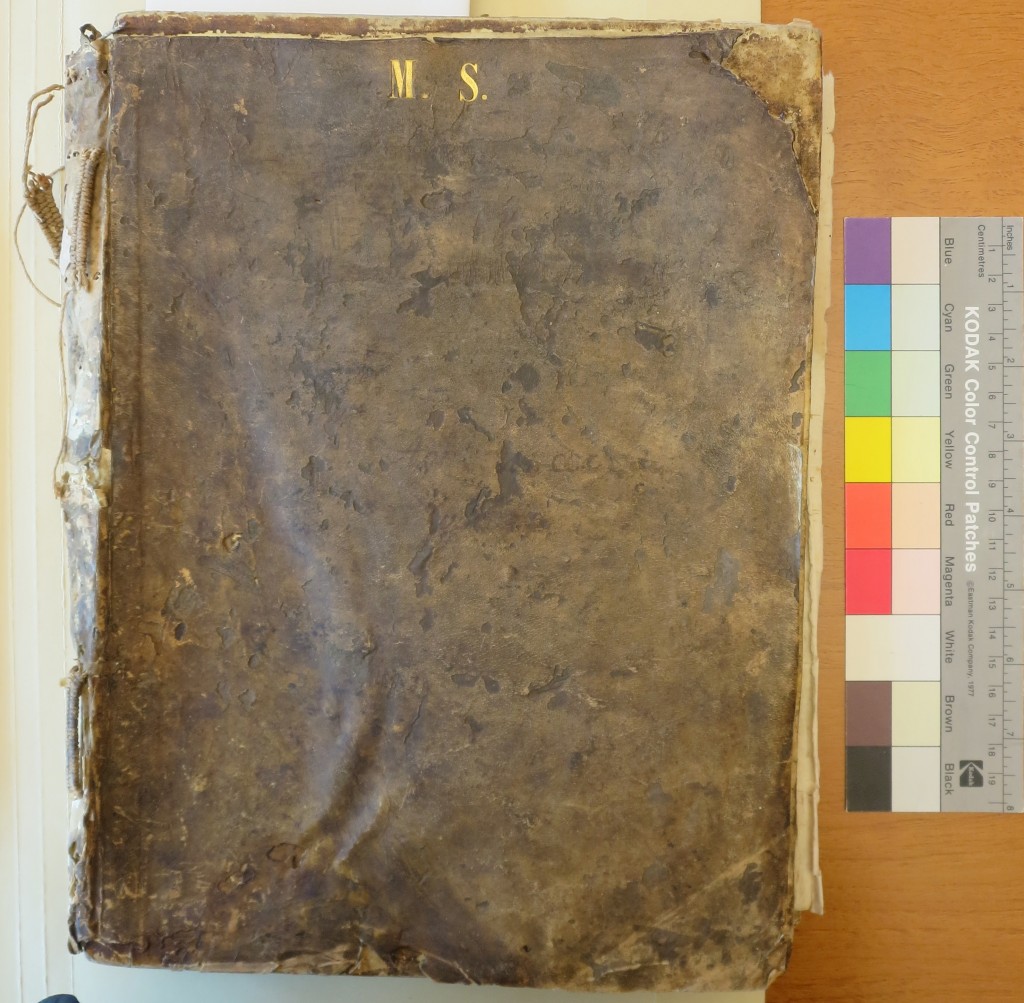
Otto Ege Collection, Beinecke Rare Book and Manuscript Library, Yale University. Ege Manuscript 51, Volume II, Front Cover. Photograph Mildred Budny.
Any gilt edges and the stitching patterns in the gutters of dispersed leaves could be the sole surviving tangible traces of that former binding.
Some Known Leaves
A preliminary, virtual reconstruction of known leaves from this book unfolds in our blog:
- Some Leaves in Set 1 of ‘Ege’s FOL Portfolio’ (Ege MSS 8, 14, 19, and 41)
A specimen page from the Old Testament:
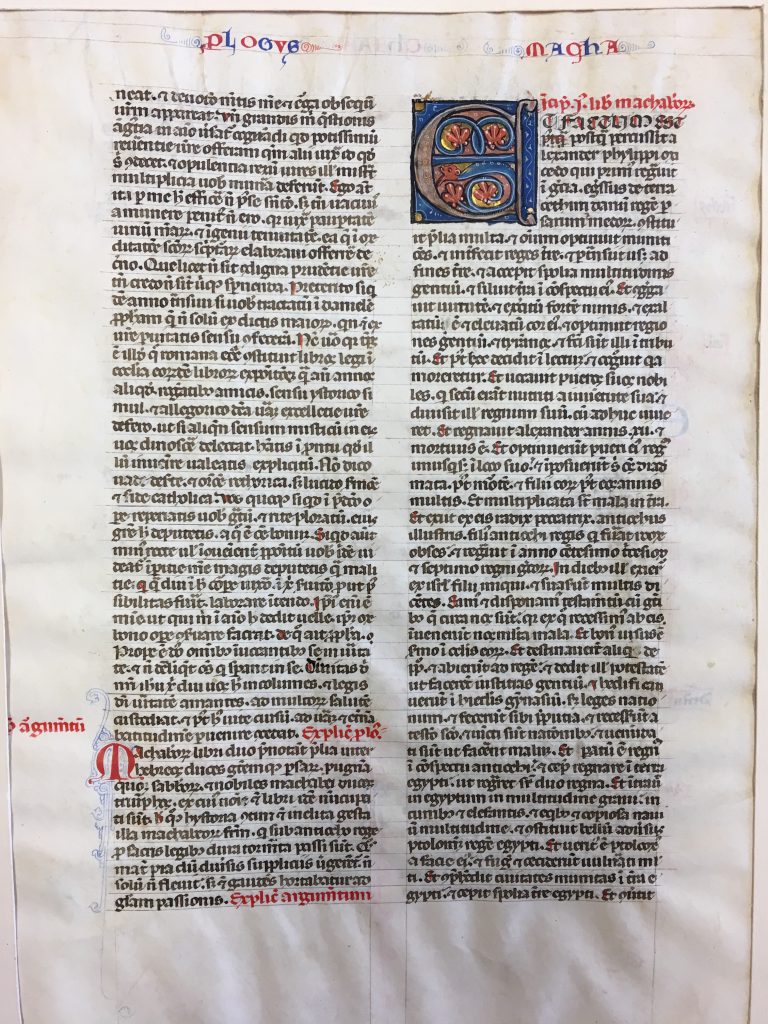
J. S. Wagner Collection. Leaf from Ege Manuscript 19, verso.
A specimen page from the New Testament
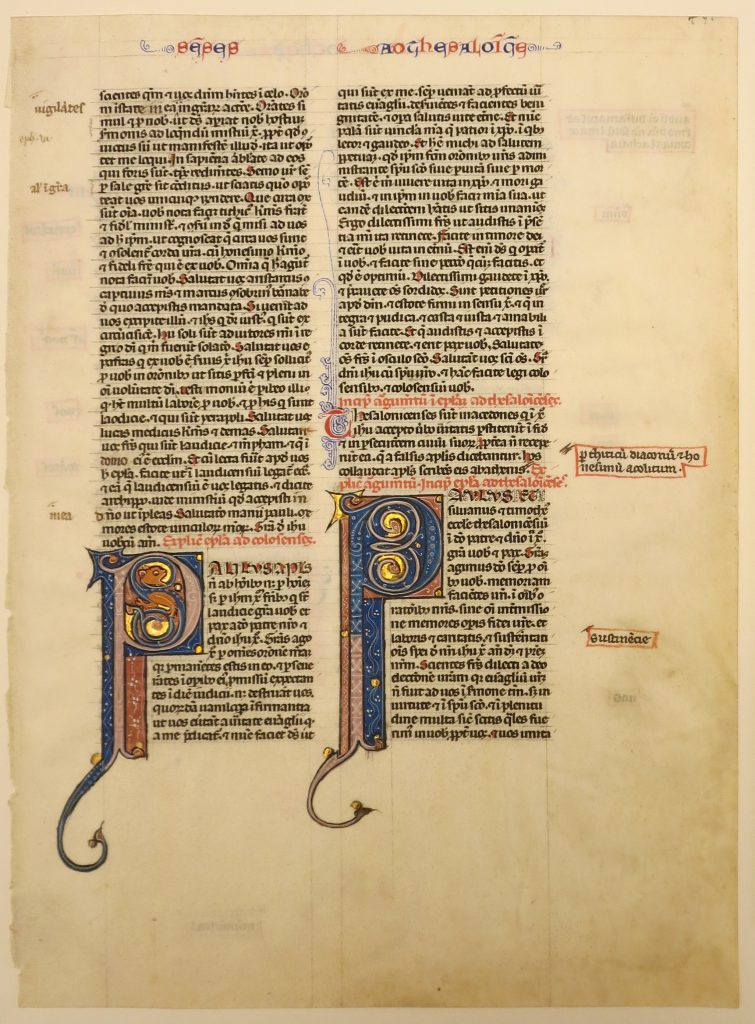
New Haven, Yale University, Beinecke Rare Book and Manuscript Library, Otto Ege Collection, Family Portfolio of Fifty Original Leaves (“FOL”) of Medieval Western Manuscripts, Leaf 19, recto. Photography by Mildred Budny.
The “Interpretation of Hebrew Names” as Companion
The Sotheby’s catalogue informs us of the former presence of the Interpretatio Nominorum Hebraeorum or “Interpretation of Hebrew Names” (“INH” or “IHN”) — a customary study-aid for the Vulgate Bible. Without an indication of how this glossary-like text began, it is uncertain — until leaves from it surface into view — to which version (among many) that text belonged.
We learn that it occupied 32 leaves and stood at the end of the manuscript. Perhaps its layout conformed with the double columns and number of lines of the Biblical Books? It is not uncommon to find a different layout, say in 3 columns, for the INH within a medieval Vulgate Bible manuscript that would present the Bible and Prologues in double columns as standard practice.
An example examined in our blog pertains to A New Leaf from ‘Otto Ege Manuscript 14’.
The layout for its Bible texts:

Beinecke Rare Book & Manuscript Library, Otto Ege Collection, MS 14, Bifolium in 3 Esdras opened to 2:16 – 5:19. Photograph Mildred Budny.
The layout for its IHN:
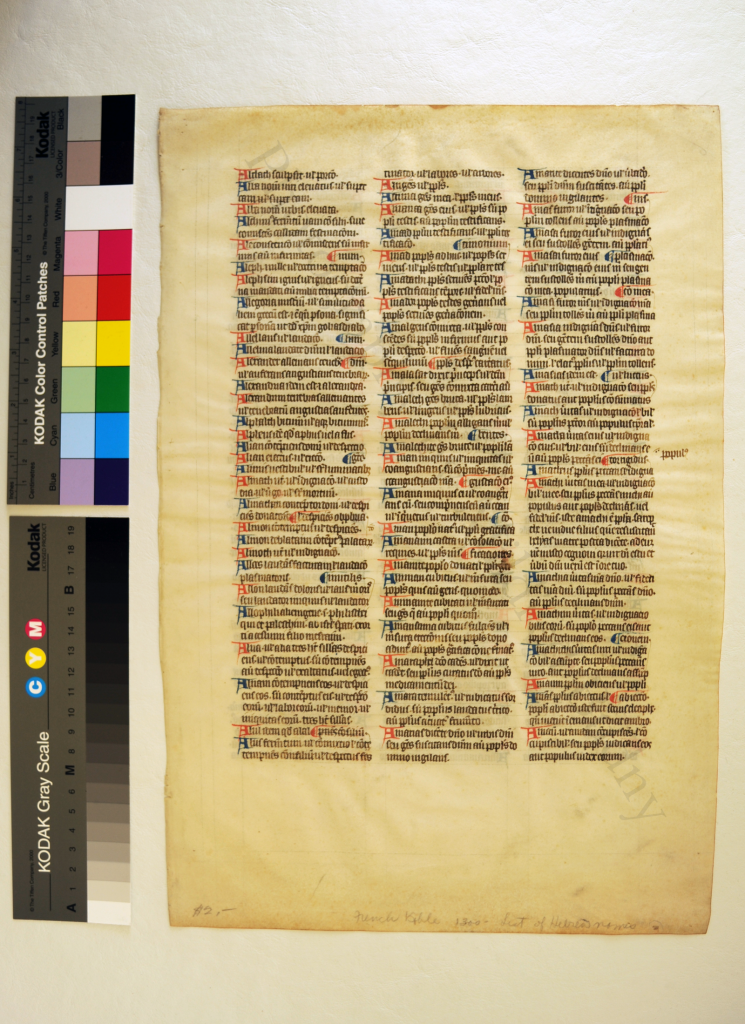
Private Collection, Leaf from Ege MS 14, with part of the A-Group of the ‘Interpretation of Hebrew Names’. Photograph by Mildred Budny.
For Ege Manuscript 14, so far I know only of 3 leaves, from 2 of its letter groups: the A-Group and the I-Group. As we see, they are laid out in triple columns, unlike the double-column format of the Bible text.
For Ege Manuscript 19, so far, no parts of the IHN have come into view. Unless, say, its initials and decoration pertain to the recognizable style of the Bible leaves, or they belong to some residue left over after Ege’s pickings for dispersal, or — like the “New Leaf” from Ege Manuscript 14 — they carry Ege’s identifying inscription in pencil in a lower margin, they may be difficult to identify as such. As a clue, Ege’s identifying inscription for Ege Manuscript 19 takes such a form:

New Haven, Yale University, Beinecke Rare Book and Manuscript Library, Otto Ege Collection, Family Portfolio of Fifty Original Leaves (“FOL”) of Medieval Western Manuscripts, Detail of Mat for Leaf 19. Photography by Mildred Budny.
The Numbers Game
The Sotheby’s reported total of 498 leaves for the manuscript and 32 leaves for its Interpretation of Hebrew Names at the end yields a total of 466 leaves for the Old and New Testament, Prologues included. Who knows if the count included any endleaves which stood outside all those texts?
Some leaves retain folio numbers in ink, in full or in part. Many of the numbers have been trimmed away at the top, presumably for rebinding at some stage. .

UNCG University Libraries, University of North Carolina at Greensboro, Leaf from Ege MS 14, original recto, upper half. Image Public Domain.
Most probably that trimming occurred by other hands than Ege’s, because his workshop practices in dismembering manuscripts seem to have focused upon cutting the leaves away from the stitching of the binding by a slice down the length of the gutter or inner fold in the bifolia. Trimming the margins would been redundant — and unnecessary — because any cropping of the pages would be accomplished by the windowed mats behind which the presented specimen leaves would stand.
As at the Beinecke Rare Book & Manuscript Library:

New Haven, Yale University, Beinecke Rare Book and Manuscript Library, Otto Ege Collection, Family Portfolio of Fifty Original Leaves (“FOL”) of Medieval Western Manuscripts, Leaf 19, Photography by Mildred Budny.
Therefore, unless someone other than Ege purchased Ege Manuscript 19 from Sotheby’s in 1936 and altered it in any ways before it came to Ege, we should expect that the trimming of the text-block of the manuscript occurred in a rebinding before it left the Lacaita Collection, or perhaps even before then.
Without most of the internal evidence which the full manuscript would have contained, it is hard to guess which travels the manuscript underwent during the centuries between its production, use, and transfer between collections until it surfaced in London and moved to the United States. The stages of its transformation into pieces and their dispersal from Ege’s collection to many different collections in several countries have a different pattern of transmission.
Tracking any or all of them requires detective work on multiple levels.
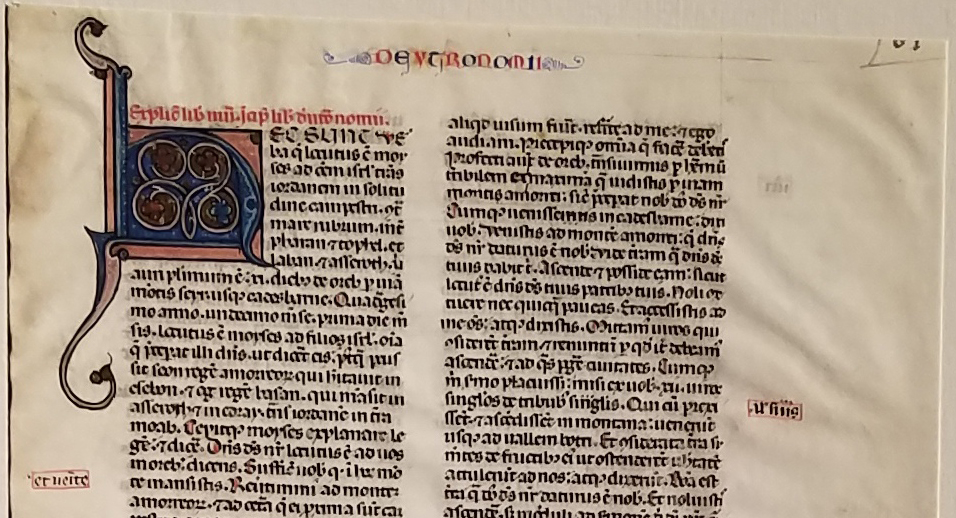
Set 1 of Otto Ege’s FOL Portfolio, Leaf 19 recto top.
A Question of Style
Ege’s printed label for MS 19 accompanies its selected Specimens. As with the leaf in the J. S. Wagner Collection (albeit with alterations in pencil to the number):
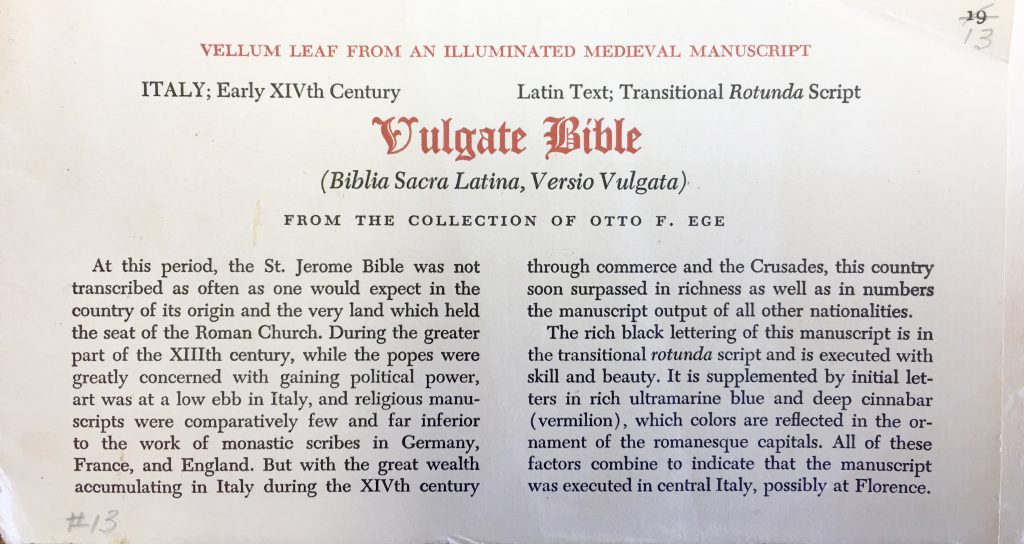
J. S. Wagner Collection. Otto Ege’s printed Label for his Specimens of Leaf 19 in the Portfolio of Fifty Original Leaves from Medieval Manuscripts. Western Europe, XII-XVI Century.
Another Sotheby’s auction catalogue, some 50 years after the sale of the manuscript, gave an updated pronouncement about the style. A group of 18 leaves evidently from this manuscript joined a sale at Sotheby’s of 54 lots (lots 39–92) of “Manuscripts from the Collection of Otto F. Ege”. The catalogue of Western Manuscripts and Miniatures sold in London on Tuesday 26th November 1985 includes no plate, but it describes lot 60 thus:
EIGHTEEN LEAVES FROM A LATIN BIBLE, ILLUMINATED MANUSCRIPT ON VELLUM [ITALY, C. 1300]
18 leaves, mostly detached (one bifolium), double column, 48 lines, written-space 152mm. by 105mm., chapter initials throughout in red or blue with good contrasting penwork, NINE LARGE ILLUMINATED INITIALS in designs of flowers and dragons in colour and burnished gold, foliation in ink in a post-medieval Italian hand (now slightly cropped), generally in fine condition (235mm. by 170mm.)
A finely written Bible probably illuminated in northern Europe, perhaps in Paris where stationers evidently decorated Bolognese manuscripts for resale.
By this time, a distinction had come to be drawn between the script of the manuscript (Italy, circa 1300, “finely written”) and the illuminated decoration (“northern Europe, perhaps in Paris . . . “). Such a view, sometimes with variations, can be seen in sales catalogues for some other leaves from the book. Some of those catalogues are listed for Scott Gwara’s Handlist of Manuscripts and Fragments Collected or Sold by Otto F. Ege (2013), number 19 (page 124). For that item, Gwara contrasted the descriptions:
“Ege Description” [that is, on Ege’s printed label for MS 19, as shown above here]
ITALY, Early XIVth Century. Latin Text, Transitional Rotunda Script. Vulgate Bible (Biblia Sacra Latina, Versio Vulgata).
“Gwara Description”
Italy (possibly Bologna, with Paris illuminations), ca. 1275: 235 × 170 mm (written area 153 × 107 mm), Double column, 48 lines.
For now, we set aside the question of stylistic attribution for further exploration at another stage.
Meanwhile, we note the Comment offered for our first blogpost. Sabrina Zanno remarked:
Very interesting! I’m curious to know you think it was made in Paris. The decorations do not seem Parisian to me. I’d suggest that you take into consideration another possible provenance from Southern France instead.
*****
Do you know of more leaves from this book, or by its same hands?
Please let us know your suggestions and feedback. Add your Comments here, Contact Us, and visit our Facebook Page.
*****
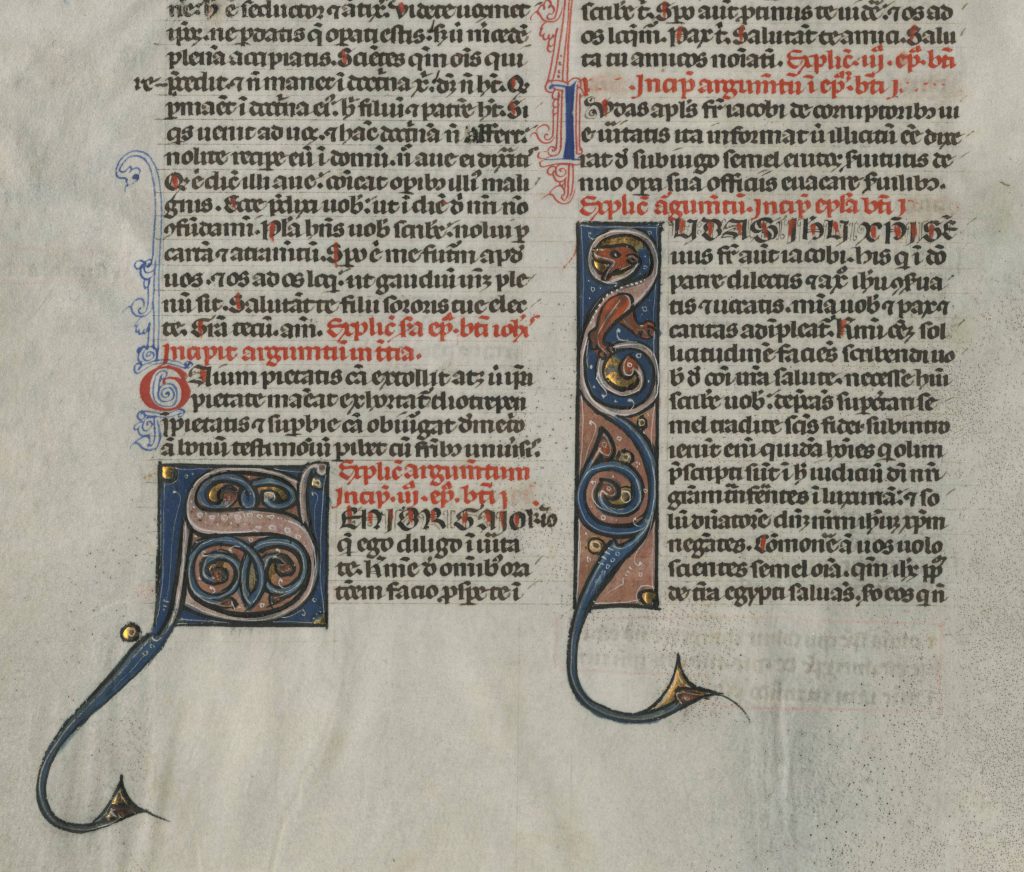
UNCG University Libraries, University of North Carolina at Greensboro, Leaf from Ege MS 14, original verso, lower half. Image Public Domain.
